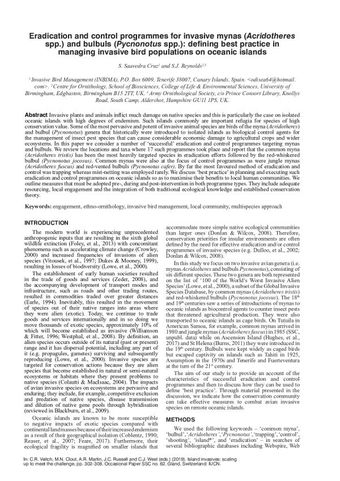The use of Starlicide in preliminary trials to control invasive common myna Acridotheres tristis populations on St Helena and Ascension islands, Atlantic Ocean
- Description:
- Introduced common mynas Acridotheres tristis have been implicated as a threat to native biodiversity on the oceanic islands of St Helena and Ascension (UK). A rice-based bait treated with Starlicide® was broadcast for consumption by flocks of common mynas at the government rubbish tips on the two islands during investigations of potential myna management techniques. Bait was laid on St Helena during two 3-day periods in July and August 2009, and on Ascension over one 3-day period in November 2009. As a consequence of bait ingestion, dead mynas were found, especially under night roosts and also at the main drinking area on Ascension, following baiting. On St Helena early morning counts at the tip suggested that whilst the number of mynas fell after each treatment, lower numbers were not sustained; no reduction in numbers flying to the main roost used by birds using the tip as a feeding area was detected post-treatment. On Ascension, the number of mynas that fed at the tip and using a drinking site, and the numbers counted flying into night roosts from the direction of the tip, both indicated declines of about 70% (from about 360 to 109 individuals). Most dead birds were found following the first day of bait application, with few apparently dying after baiting on days 2 and 3. Despite the low concentration of Starlicide used, aversion to the bait was apparent during the trials. These results indicate that Starlicide may contribute to myna control programmes but questions remain over the mode of action of the chemical (in terms of individual differences among birds the responses to its toxic properties) and the longer-term susceptibility of birds to baiting.
- Display date:
- 2010
- Collections:
- Secretariat of the Pacific Regional Environment Programme (SPREP)
- Publisher:
- Conservation Evidence
- Content partner:
- Secretariat of the Pacific Regional Environment Programme (SPREP)
- Availability:
- Not specified
-
Copyright status: All rights reservedFind out more about what you are able to do with this itemThis item is all rights reserved, with means you'll have to get permission from Secretariat of the Pacific Regional Environment Programme (SPREP) before using it. For more information, please see our use and reuse page.What can I do with this item?Non-infringing useNZ copyright law does not prevent every use of a copyright work, and this item may be hosted by an international institute or organisation. You should consider what you can and cannot do with a copyright work.No sharingYou may not copy and/or share this item with others without further permission. This includes posting it on your blog, using it in a presentation, or any other public use.No modifyingYou are not allowed to adapt or remix this item into any other works.No commercial useYou may not use this item commercially.
Related items
Welcome and warm Pasifik greetings
The information on this site has been gathered from our content partners.
The names, terms, and labels that we present on the site may contain images or voices of deceased persons and may also reflect the bias, norms, and perspective of the period of time in which they were created. We accept that these may not be appropriate today.
If you have any concerns or questions about an item, please contact us.
